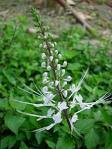 Hibiscus is beautiful flowering plant that grows
in tropical and warm regions. It has a distinctively pretty flower in its wide
variety of species. It is the national flower of South Korea, Malaysia and
Republic of Haiti. Considered as an auspicious flower in India, it is used in
many rituals and offerings to the God. Apart of this, there are a lot of
medicinal uses of Hibiscus leaves and flower. In the ancient Indian medicinal
system of Ayurveda, it has been used for treating several ailments and conditions
for centuries. Uses of Hibiscus leaves are not only used medicinally, they are
consumed in different forms and many a times used as ornamental offerings and
general landscaping in gardens and parks. Hibiscus leaves are processed in
various forms for different uses. Dried Hibiscus leaves are used as garnishing
in various cuisines like Mexican. Its flower is used to make a form of tea that
is popular in several countries with various names. Medicinal uses of Hibiscus
leaves are proved scientifically through various researches. A 2008 study has
shown that consuming hibiscus tea lowers blood pressure. In Ayurveda, red and
white Hibiscus are considered of high medicinal value and used in various forms
to treat cough, hair loss and hair greying. It is also rich in antioxidants
that are used for anti-ageing purposes. Tea of hibiscus leaf is also consumed
to elevate mood.
Hibiscus is beautiful flowering plant that grows
in tropical and warm regions. It has a distinctively pretty flower in its wide
variety of species. It is the national flower of South Korea, Malaysia and
Republic of Haiti. Considered as an auspicious flower in India, it is used in
many rituals and offerings to the God. Apart of this, there are a lot of
medicinal uses of Hibiscus leaves and flower. In the ancient Indian medicinal
system of Ayurveda, it has been used for treating several ailments and conditions
for centuries. Uses of Hibiscus leaves are not only used medicinally, they are
consumed in different forms and many a times used as ornamental offerings and
general landscaping in gardens and parks. Hibiscus leaves are processed in
various forms for different uses. Dried Hibiscus leaves are used as garnishing
in various cuisines like Mexican. Its flower is used to make a form of tea that
is popular in several countries with various names. Medicinal uses of Hibiscus
leaves are proved scientifically through various researches. A 2008 study has
shown that consuming hibiscus tea lowers blood pressure. In Ayurveda, red and
white Hibiscus are considered of high medicinal value and used in various forms
to treat cough, hair loss and hair greying. It is also rich in antioxidants
that are used for anti-ageing purposes. Tea of hibiscus leaf is also consumed
to elevate mood.  Here are several medicinal uses of Hibiscus
leaves. If hair fall is the major problem
to you, hibiscus flower can act as a wonderful remedy. Since this flower has a
great combination of vitamin C, Phosphorous, riboflavin and calcium, you can
get a soothing hair along with restriction of hair fall. Your hair will get
enough nourishment as the hibiscus flower contains carotene which also
restricts graying of hair at a very early stage. Regular using of hibiscus
flower juice can easily restrict hair fall control, dandruff and graying of
hair even when you are touching 50 years of age. This is an age-old remedy for
all those people who have been struggling for healthy hair that is free
from grey hair.
Here are several medicinal uses of Hibiscus
leaves. If hair fall is the major problem
to you, hibiscus flower can act as a wonderful remedy. Since this flower has a
great combination of vitamin C, Phosphorous, riboflavin and calcium, you can
get a soothing hair along with restriction of hair fall. Your hair will get
enough nourishment as the hibiscus flower contains carotene which also
restricts graying of hair at a very early stage. Regular using of hibiscus
flower juice can easily restrict hair fall control, dandruff and graying of
hair even when you are touching 50 years of age. This is an age-old remedy for
all those people who have been struggling for healthy hair that is free
from grey hair.
We can supply Hibiscus Flowers and Leaf
For More Details Contact
Mobile :98433 19923 / 98434 19923 / 97509 19923
Email : akilexportss@gmail.com




